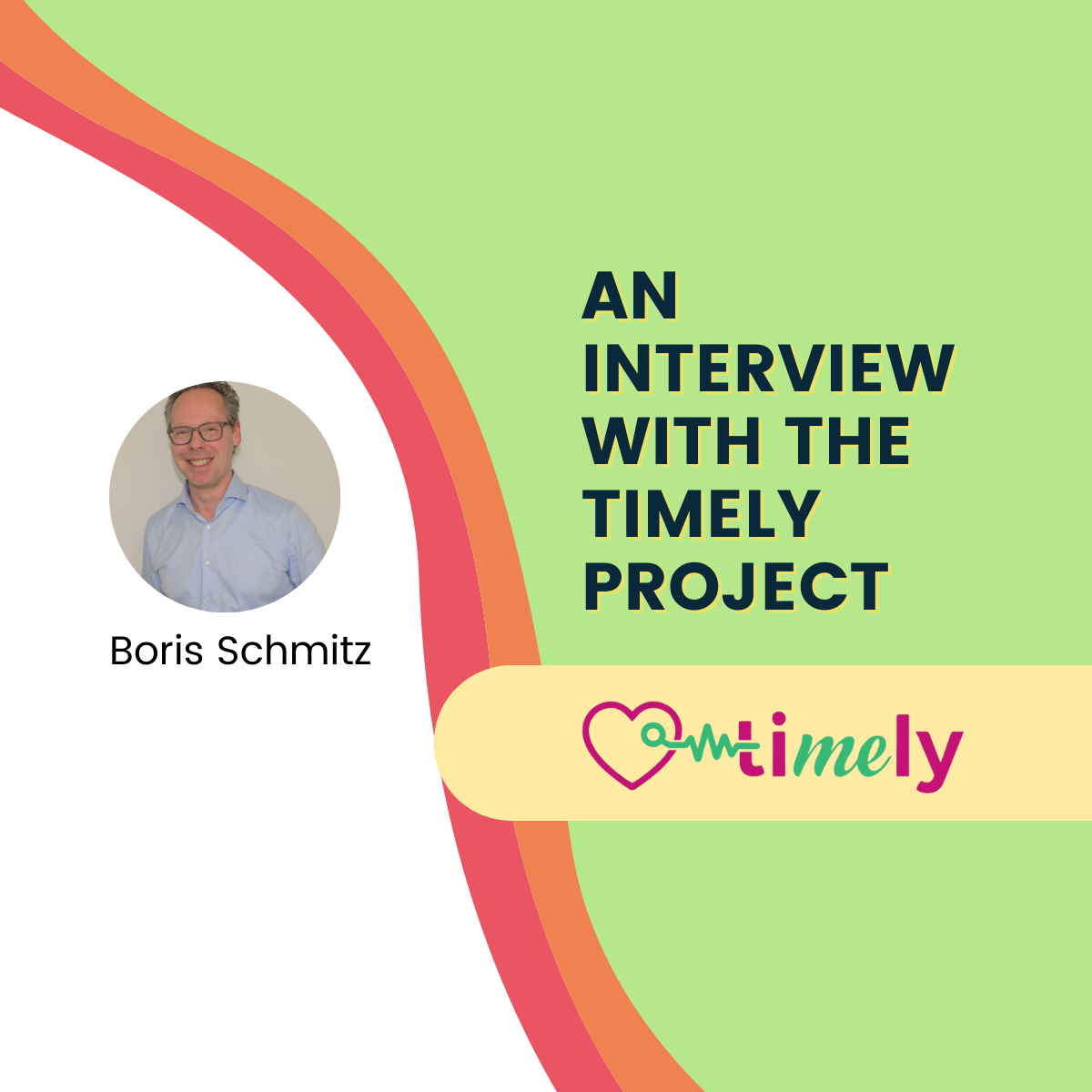
News
26/08/2024
We had the pleasure of speaking with a team member of the EU-funded TIMELY project, Boris Schmitz. He answered our questions surrounding the aim, development and future plans of the project new approach for the management of CAD patients.

What is the goal of the TIMELY project?
The goal of the EU-funded TIMELY project is to develop an AI-powered platform to support the early risk prediction, prevention, and intervention for patients with coronary artery disease (CAD). The platform aims to personalize healthcare by evaluating risks, predicting outcomes, and providing tailored interventions. It is designed to be interoperable with electronic health records and mobile devices to monitor and assess risks continuously. TIMELY seeks to improve patient adherence to cardiac rehabilitation programs and enhance long-term disease management.
Is TIMELY only focusing on coronary heart disease, or are other cardiovascular conditions being considered?
The TIMELY project primarily focuses on CAD, and specifically addresses secondary prevention, emphasizing the importance of sustained lifestyle changes and continuous monitoring to prevent further cardiac events.
However, TIMELY offers a comprehensive approach to cardiovascular health and rehabilitation based on behavioral change-based lifestyle interventions and risk assessments that can be beneficial in a wider range of chronic conditions.
How are the patient perspective and requirements considered?
The integration of patient perspectives and requirements into all TIMELY tools is achieved through user-centered design. This involves capturing patient needs in a “living lab” – through research, interviews, and usability testing. Engaging patients throughout the development process is crucial for understanding their expectations, concerns, and priorities. Ethics, data privacy, and transparency are fundamental to ensure trust. Educating patients about the functionality and benefits of the app promotes informed decision-making and compliance. Continuous feedback and improvements are essential for adapting the tools to evolving needs.
How do you plan to integrate TIMELY into existing or new patient pathways?
TIMELY can be incorporated into pension insurance offerings as part of initiatives aimed at maintaining and improving the health of the workforce. By providing early interventions and promoting healthy lifestyles, TIMELY can contribute to reducing the incidence of work-related health issues, thus prolonging the working life of individuals. Moreover, TIMELY could be offered by health insurance companies either as a complementary digital service within existing prevention and health promotion programs provided or as a new program aiming at increasing quality of life and therapy adherence.
Integrating TIMELY into existing or new programs and patient pathways involves several strategic approaches to ensure smooth adoption and effective utilization within healthcare systems. Firstly, TIMELY ensures interoperability with existing electronic health records, enabling seamless data integration and continuity of care. This means patient data from the TIMELY platform can be safely accessed and shared among caretakers, enhancing coordinated care efforts.
Real-time feedback loops facilitate timely interventions and adjustments to treatment plans, which can be incorporated into routine follow-up protocols whenever needed along the continuum of care.
TIMELY also focuses on personalized interventions by offering AI-driven lifestyle and behavioral recommendations tailored to individual risk profiles. These personalized plans are designed to fit into patients’ ongoing care routines, supporting long-term adherence and healthier lifestyles.
Moreover, the platform empowers patients with tools for self-management, such as chatbots and digital coaches that offer guidance and support. This aspect of TIMELY helps patients maintain their health independently, integrating self-management into their daily lives and ongoing care pathways.
To ensure effective integration, TIMELY includes training for healthcare providers on how to use the platform and interpret its data. This training helps embed TIMELY’s functionalities into clinical workflows, making it a part of standard care practices.
How will you know if the Timely platform is effective?
TIMELY is conducting a randomized controlled trial in three countries to evaluate its effectiveness and refine its integration strategies. This RCT will provide insights into the best practices for incorporating TIMELY into various healthcare settings.
By focusing on these areas, TIMELY additionally tests how the platform can be incorporated into existing care pathways and possibly create new, more efficient ones that leverage technology across settings and countries for better cardiovascular care.
Finally, TIMELY is conducting a randomized controlled trial in three countries to evaluate the effectiveness of the platform and refine its integration strategies.
Which tools do you give users to sustainably change their lifestyle?
The TIMELY app offers tools to help users sustainably change their lifestyle, including personalized recommendations, chatbot, activity tracking, and goal setting. The app integrates these features to provide continuous monitoring and real-time feedback, enhancing user engagement and adherence. Educational resources further motivate patients. The app’s user-friendly design ensures easy navigation and access to tailored health advice, fostering long-term lifestyle changes.
How will you evaluate the effectiveness and safety of your platform and app?
Firstly, TIMELY is conducting a randomized controlled trial (RCT) across three European centers, enrolling patients with CAD. This trial will measure key health outcomes, including biomarker scores reflecting long-term mortality risk and physical fitness assessments such as the 6-minute walk test. Changes in diet and exercise behavior will also be analyzed to gauge the effectiveness of the app in promoting sustained lifestyle changes.
Additionally, the platform’s data analytics capabilities will continuously monitor patient health data, enabling the assessment of real-time intervention effectiveness and early detection of any adverse events. This continuous monitoring ensures that both the short-term and long-term impacts of using the app are thoroughly evaluated.
User feedback will play a crucial role and patient experiences and adherence to the app’s recommendations will be collected and analyzed to understand user engagement and the practical benefits of the interventions provided.
These comprehensive evaluation methods will provide robust evidence on the TIMELY app’s effectiveness and safety, guiding further improvements and wider implementation within healthcare systems.
What are the AI tools being used?
Actually, there are two groups of tools, those used for supporting clinicians and case managers and those addressed to patients.
Clinicians and case managers are using TIMELY AI tools to:
- Predict the risk for secondary cardiac events, mainly post PCI (Percutaneous coronary intervention) based on the available EHR, lab and clinical data
- Predict the adherence to and effectiveness of cardiac rehabilitation, also based on the available EHR and clinical data
- Predict crucial cardiopulmonary metrics reflecting submaximal and maximal exercise capicity post-rehabilitation based on Pulse Wave Analysis (PWA)
- Detect atrial fibrillation from ECG and Pulse Wave Analysis
- Suggest the most suitable weekly exercise regime for each patient (based on activity tracker data, clinical info, stress tests)
The tools addressed to patients include a chatbot and context aware recommendations urging patients to be more active. First it provides a ‘pocket-therapist’, which is a chatbot that supports patients with counselling support to identify and overcome hurdles and challenges to the needed life style change. Further, it provides the patient with context-dependent reminders and prompts. For example, if the weather forecast is nice, the patient is encouraged to plan a walk, but if the weather forecast is bad, the AI tool provides suggestions for indoor activities.
Is the project developing its own AI tools or implementing pre-existing tools?
The project in developing its own tools with data either collected in previous studies (LUdwigshafen RIsk and Cardiovascular Health (LURIC), Vorarlberg Institute for Vascular Investigation and Treatment (VIVIT), UK Biobank to name a few) or own data from the Living Lab activities designed to “feed” with valuable and unique data the development of the AI tools.
What types of data are being used with the AI?
Clinical and laboratory work up, phenotypes, diagnostic data, data on medication, diet, psychosocial and physical activity are being used. Also follow up data for most categories as well as program adherence and endpoints including (cardiovascular) mortality, MACCE
and rehospitalization for analysis of secondary prevention in CAD.
Are the tools being developed scalable? Can the applicability of the AI tools be extended to other conditions?
Most tools can be extended with a few adjustments to any condition for which cardiac rehabilitation is suggested based on clinical guidelines. Some tools like the one for AF detection are scalable by their nature.
How will TIMELY impact healthcare systems across Europe?
It will do that in five ways. First, as discussed earlier, the TIMELY project aims to enhance cardiovascular care in Europe by providing personalized, AI-driven interventions and continuous monitoring, leading to improved patient outcomes and reduced healthcare costs. Second, it is developed to integrate seamlessly with existing electronic health records, ensuring better data coordination and continuity of care. Third, by promoting early risk prediction and preventive measures, TIMELY shifts healthcare from reactive to proactive management. Fourth, the platform empowers patients with self-management tools, contributing to better adherence and healthier lifestyles. Finally, the project supports healthcare professionals with training, fostering a technologically adept workforce and generating evidence to inform future healthcare policies.





